英语教学课件系列Zhalong-Aspecialplace
- 格式:pdf
- 大小:3.35 MB
- 文档页数:19
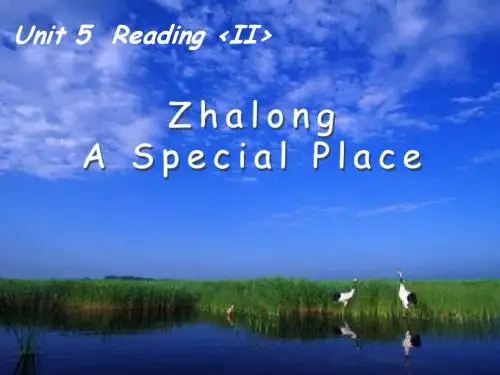
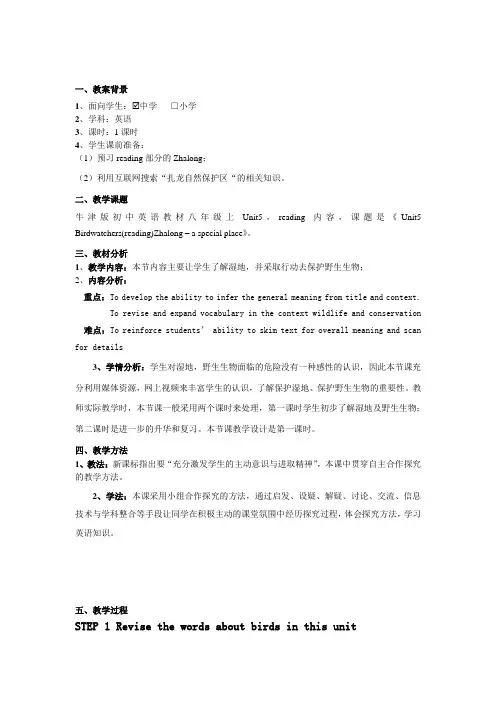
一、教案背景1、面向学生: 中学□小学2、学科:英语3、课时:1课时4、学生课前准备:(1)预习reading部分的Zhalong;(2)利用互联网搜索“扎龙自然保护区“的相关知识。
二、教学课题牛津版初中英语教材八年级上Unit5,reading内容,课题是《Unit5 Birdwatchers(reading)Zhalong – a special place》。
三、教材分析1、教学内容:本节内容主要让学生了解湿地,并采取行动去保护野生生物;2、内容分析:重点:To develop the ability to infer the general meaning from title and context.To revise and expand vocabulary in the context wildlife and conservation 难点:To reinforce students’ ability to skim text for overall meaning and scan for details3、学情分析:学生对湿地,野生生物面临的危险没有一种感性的认识,因此本节课充分利用媒体资源,网上视频来丰富学生的认识,了解保护湿地、保护野生生物的重要性。
教师实际教学时,本节课一般采用两个课时来处理,第一课时学生初步了解湿地及野生生物;第二课时是进一步的升华和复习。
本节课教学设计是第一课时。
四、教学方法1、教法:新课标指出要“充分激发学生的主动意识与进取精神”,本课中贯穿自主合作探究的教学方法。
2、学法:本课采用小组合作探究的方法,通过启发、设疑、解疑、讨论、交流、信息技术与学科整合等手段让同学在积极主动的课堂氛围中经历探究过程,体会探究方法,学习英语知识。
五、教学过程STEP 1 Revise the words about birds in this unit‘A guessing game’Show the students pictures of the birds that we learnt in the part ‘Welcome to the unit’. Get them to guess it.Of the six pictures, the last one is the picture of a crane. (Teach the word ‘crane’, and the phrase “rare red-crowned crane’ and make sure that they can read it well.)STEP 2 Pictures of the wetland and ZhalongT: Do you know where the rare red-crowned cranes mostly live? S: In the wetland.S: In the nature reserve.T: Which wetland will we learn about then?S: Zhalong. (They answer it together.)Show the students a picture of Zhalong nature reserve.STEP 3 Check their homeworkKnow some of the words in the article. Choose the right meaning for each word. (Part B1 on page78 in the English book.)STEP 4 SkimGet the students to skim the article and put the following pictures in the correct order.图片来源:/photo/2007-07/24/content_642043 7.htm;/2004-09-23/1/5984.html. STEP 5 Watch the video and listen carefullyGet the students to watch the video and listen carefully. ThenSTEP 6 Ask and answer1.Get the students to watch the video again .2.Get the students to try to ask as many questions as they canSTEP 7 Main ideas1.Get the students to divide the article into 3 parts and find out the main idea of each part.Paragraph1-2: a special placeParagraph3-4: dangerParagraph5-6: actions2.Read paragraph 1-2 Get the students to focus on the question “Why is Zhalong a special place?”Useful expressions (appear on the screen):specialone of…wetlands many birds live comfortably in…provides food and shelter an important living area for…an ideal home(plants, fish, birds) rare red-crowned cranes 3.Read paragraph 3-4. Get the students to focus on “whatdanger does the reserve have?”Useful expressions(appear on the screen):wetlands: people, change…to…wildlife: …less and less space…4.Read paragraph5-6. Get the students to talk about “Actionsto protect birds in Zhalong”.Useful expressions(appear on the screen):图片来源:/i?ct=503316480&z=0&tn=baiduimagedeta il&word=%D0%EC%D0%E3%BE%EA&in=1672&cl=2&lm=-1&st=-1&pn=1&rn =1&di=1535669175&ln=781&fr=&fm=index&fmq=1332136901984_R&ic =&s=0&se=&sme=0&tab=&width=&height=&face=&is=&istype=2#pn1& -1&di1535669175&objURLhttp%3A%2F%%2Fmp1%2Fimag es%2F2008-01%2F11%2FZ03111C006_b.jpg&fromURLhttp%3A%2F%2Fxh %2Fmp1%2Fhtml%2F2008-01%2F11%2Fcontent_6061511.htm &W300&H225&T7516&S62&TPjpg“Actions to protect birds”, to introduce this story about Xuxiujuan is to arouse the students’ interest.(旁白:有一个女孩她从小爱养丹顶鹤在她大学毕业以后她仍回到她养鹤的地方可是有一天她为救那只受伤的丹顶鹤滑进了沼泽地就再也没有上来走过那条小河你可曾听说有一位女孩她曾经来过走过那片芦苇坡你可曾听说有一位女孩她留下一首歌为何片片白云悄悄落泪为何阵阵风儿为她诉说喔~啊~还有一群丹顶鹤轻轻地轻轻地飞过 )歌词来源:/question/274235280.htmlAfter the story, get the students to talk about what actionsthey will take to protect the birds.STEP 8 Check outSee how much the students know about Zhalong by doing some exercises.Introduction of Zhalong:1.Zhalong is a nature reserve in_______.A.north-west ChinaB. south-east ChinaC. north-east ChinaD. south-west China2. Zhalong is one of the world’s most important _____.A.FarmsB. wetlandsC. mountainsD. parks3. The area provides __________ for wildlife.A.Food and waterB. food and shelterC. sunshine and shelterD. food and sunshine4. Zhalong is an important living area for the ______.A.TigersB. pandasC. bearsD. red-crowned cranes“T” or “F” (be careful):1.Zhalong is a nature reserve in China. ____2.Birds can find food easily in Zhalong. ____3.Some birds go to Zhalong for a short stay. ____4.The birds in Zhalong live in large cages. ____5.There are a lot of red-crowned cranes in otherparts of the world. ____6.Many endangered birds live in Zhalong now. ____7.Zhalong needs more people to feed birds. ____8.Studying Zhalong helps us learn about protecting wildlife.____Read and fill in the blanks:Zhalong is a _(1)_ reserve in north-east China. It’s one ofthe world’s most important _(2)__. It _(3)__ food and _(4)_for wildlife.So it is an _(5)_ home for some endangered wildlife.But some people want to change the wetlands to make more _(6)_for farms and buildings. There will be less and less _(7)_ spacefor wildlife. Many of them _(8)_. Every year, members of the Birdwatching Club go there to _(9)_ the different kinds of birdsand do a bird _(10)_ to know the _(11)_ in their numbers. Theyhope they can make people understand the _(12)_ of the wetlandsand _(13)_ take action to protect wildlife.Finish the dialogue:cranes endangered ideal wetlands wildlifeDaniel: Why is it important to protect the _______ in Zhalong?Lots of people can live in Zhalong if we build some houses there.Sandy: Zhalong is important for _______.Daniel: Do lots of birds go there?Sandy: Yes. Some of them go there for a short stay.Daniel: Do the other birds stay in Zhalong all year round?Sandy: Yes.Zhalong is the _____ home for_____and many other___________ birds.STEP 9 ConsolidationMake up a dialogue with your partner to talk about Zhalong likeDaniel and Sandy: (A: red-crowned craneB: a student in our class)A:I am a red-crowned crane. I live in Zhalong ,I have manyfriends there.B: I am a student in Class 6 ,Grade 8. I’m interested in different kinds of birds. Why is it important to protect the wetlands……A: Because ……B: Do all of you live in Zhalong?A: ……B: Do you have any problems living in Zhalong?A: ……B: Ok, I know. Our people will......(采取行动)to protect you. For example:A: It is so ……of you to help us. ……B: ……STEP 10 DiscussionHow can we protect wild birds? Get the students to discuss the topic from different roles with the following information.S1:A worker in ZhanglongWe should /shouldn’t…S2:A farmer:We should/shouldn’t …S3:Chinese government:We should/shouldn’t…S4:Member of Birdwatching ClubWe should/shouldn’t…Teacher: Let’s live together with wild birds in perfect harmony.STEP 11 Homework.Try to find more ways to protect the wetland and take actions to protect the wildlife.Blackboard design:。
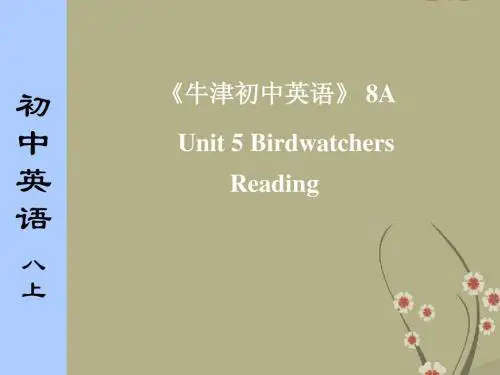
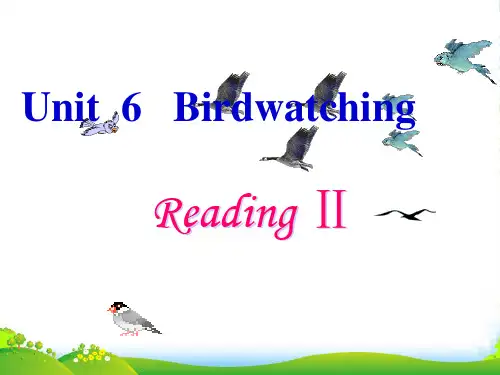
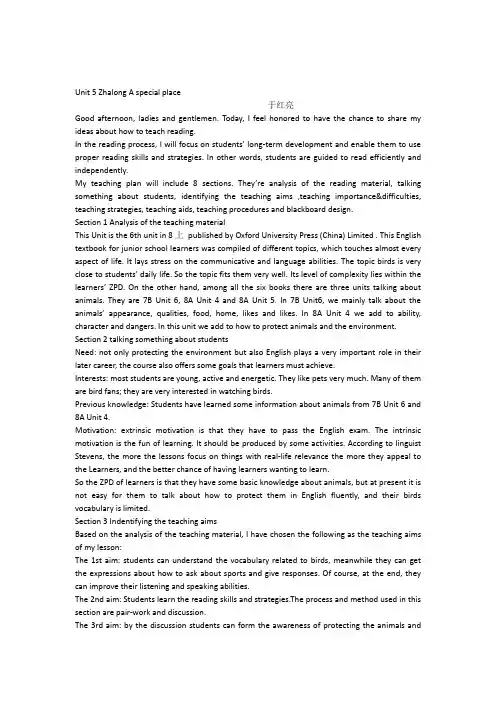
Unit 5 Zhalong A special place于红亮Good afternoon, ladies and gentlemen. Today, I feel honored to have the chance to share my ideas about how to teach reading.In the reading process, I will focus on students’ long-term development and enable them to use proper reading skills and strategies. In other words, students are guided to read efficiently and independently.My teaching plan will include 8 sections. They’re analysis of the reading material, talking something about students, identifying the teaching aims ,teaching importance&difficulties, teaching strategies, teaching aids, teaching procedures and blackboard design.Section 1 Analysis of the teaching materialThis Unit is the 6th unit in 8上published by Oxford University Press (China) Limited . This English textbook for junior school learners was compiled of different topics, which touches almost every aspect of life. It lays stress on the communicative and language abilities. The topic birds is very close to students’ daily life. So the topic fits them very well. Its level of complexity lies within the learners’ ZPD. On the other hand, among all the six books there are three units talking about animals. They are 7B Unit 6, 8A Unit 4 and 8A Unit 5. In 7B Unit6, we mainly talk about the animals’ appearance, qualities, food, home, likes and likes. In 8A Unit 4 we add to ability, character and dangers. In this unit we add to how to protect animals and the environment. Section 2 talking something about studentsNeed: not only protecting the environment but also English plays a very important role in their later career, the course also offers some goals that learners must achieve.Interests: most students are young, active and energetic. They like pets very much. Many of them are bird fans; they are very interested in watching birds.Previous knowledge: Students have learned some information about animals from 7B Unit 6 and 8A Unit 4.Motivation: extrinsic motivation is that they have to pass the English exam. The intrinsic motivation is the fun of learning. It should be produced by some activities. According to linguist Stevens, the more the lessons focus on things with real-life relevance the more they appeal to the Learners, and the better chance of having learners wanting to learn.So the ZPD of learners is that they have some basic knowledge about animals, but at present it is not easy for them to talk about how to protect them in English fluently, and their birds vocabulary is limited.Section 3 Indentifying the teaching aimsBased on the analysis of the teaching material, I have chosen the following as the teaching aims of my lesson:The 1st aim: students can understand the vocabulary related to birds, meanwhile they can get the expressions about how to ask about sports and give responses. Of course, at the end, they can improve their listening and speaking abilities.The 2nd aim: Students learn the reading skills and strategies.The process and method used in this section are pair-work and discussion.The 3rd aim: by the discussion students can form the awareness of protecting the animals andnature reserves.Section 4 teaching importance & difficulties1. According to the demands of new syllabus, this section mainly focuses on the following: Students should master the vocabulary related to birds, they can also understand and consolidate the expressions about wildlife, what’ more, they should catch the details while listening to the material.2. According to studen ts’ cognitive background, the difficulties in this section are as follows: students must express their ideas about birds and they should talk about their attitudes towards environment with their friends.Section 5 teaching strategiesSince the teaching objectives and focuses and difficulties have been specified, the following teaching strategies are mainly used in this section: Situational approach, communicative approach and interactive approachesAs to the learning strategies, meta-cognitive strategy, cognitive strategy and social/affective strategy are mainly used. The meta-cognitive strategy includes self-management, self-monitoring and self-evaluation; the cognitive strategy includes auditory-representation, contextualization and elaboration, meanwhile cooperation is used as one of the social/affective strategies. Section 6 teaching aids : a recorder, a computer, a projector and a blackboardSection 7 Teaching proceduresIn order to achieve the teaching aims mentioned above, I decide to choose guided reading and Task-Based Teaching as the main teaching approach. With the teaching methods, I can guide students to use effective reading strategies to comprehend the text, solve problems and complete different tasks. The teaching procedures include 4 parts.They’re pre-reading, while-reading, post-reading and homework.Part 1. Getting ready (pre-reading)Reading begins before a book is opened. It’s important to activate students’ existing background knowledge and draw their attention to the topic of the text. In this part, I will use the pre-reading activities to increase students’ concentration, arouse their curiosities, fire their imagination and give them a purpose for reading. The part consists of two tasks:Task 1: In this step I will play a video named a true story. It is about a college student Who lost her life in the wetland for saving a red-crowned crane. Then ask the students which bird the song is about. Students should answer “the red-crowned crane”.(With the task, I arouse the students’ curio sities and fire their imagination draw their attention to the theme of the reading material and get them ready for the following reading.)Task 2: Another question is where red-crowned cranes live in China.Ask students to listen to the tape and then answ er this question. They should answer “zhalong”. (With the task, I draw their attention to the theme of the reading material and get them ready for the following reading.)Part 2. Focusing on main facts (while-reading)First ReadingSkimming for main ideaReading Skills---Skimming(阅读技巧-略读)Run over the text quickly. Do not read every word. Try to understand the main ideas.迅速浏览课文。
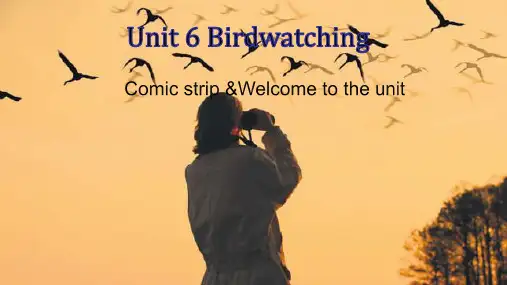
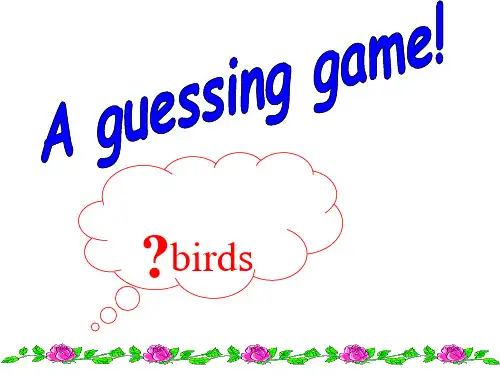
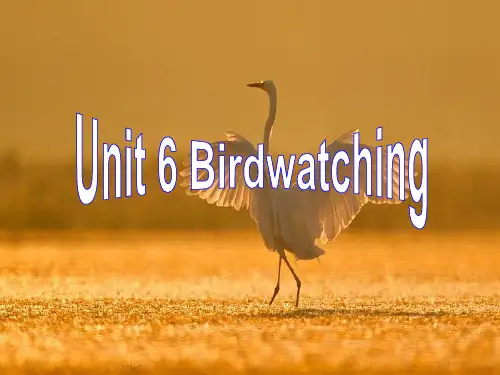

Unit 6 Bird watching Reading1教学内容8Aunit6 Birdwatching Reading1 二次备课教学目标1. To develop the ability to infer the general meaning from title and context.2. To reinforce students ability to skim text for overall meaning and scan for details重点难点Key points:To develop the ability to infer the general meaning from title and co ntext.Difficult points:To reinforce students ability to skim text for overall meaning and scan for details教学流程设计Step1 Revision1. Ask the students to talk about their favorite birds.2. Have a dictation of the new words and phrasesStep2 Presentation1. Talk about a picture of Zhalong.e.g. What can you see in the picture? ( Birds, water and land with plants)Why are so many birds here? ( They can swim and find food here.)What birds, do you think, are they?2. Talk about a picture of ‘red-crowned cranes’ and learn the new words, like wetland/cove r/crane/rare…Step3 Practice1.Listen to the tape and find the answers to the following questions:What and where is Zhalong?Is it a great place for wildlife? Why?2. Read the passage silently and focus on the questions:(1) Why is Zhalong a special place?(2) What animals live in the special place? Why?(3)Why are birds and wildlife in danger?(4) What do many tourists do there?(5)What do the members of the Birdwatching Society do?(6) What actions can we take to protect birds?3. Listen to the tape and practice reading the passage..4. Get the students to complete the following table教学流程设计Zhalong---A special placeLocation Northeast ChinaL and type WetlandImp ortance A perfect place for wildlifeProv ide food and cover forwildlifeDanger Less and less space for wildlifeActions people take Make laws to protect birds. Thebirdwatchers do a bird counteach year. They are studying thechanges in birds’ numbersHope Everyone should do something toprotect wildlifeStep4 Production1. Do exercises on Page 71 and check the answers.2. Retell the passage according to the keywords on the blackboard.(Location/ land type/ importance/ rare b irds/ dangers/ actions people take)3. Talk about Zhalong and then do Part B3andB4 on Page 72 ( C omplete the conservation between Sandy and Daniel) Homework1. Recite the new words2. Find out useful words and ph rases in Reading教学反思。
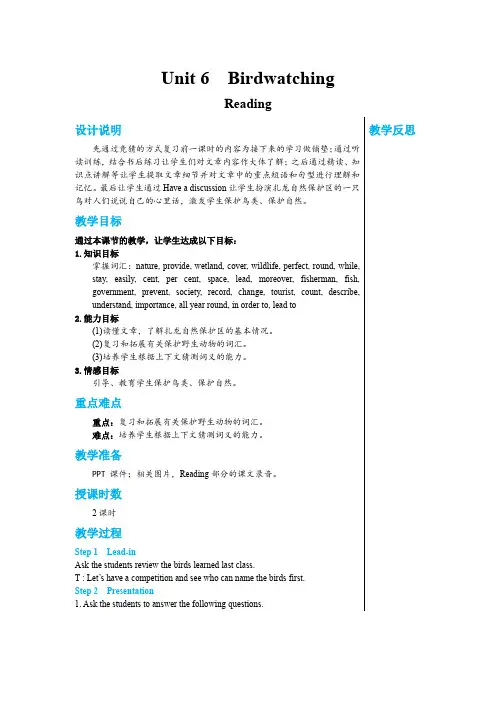
Unit 6 BirdwatchingReading设计说明教学反思先通过竞猜的方式复习前一课时的内容为接下来的学习做铺垫;通过听读训练,结合书后练习让学生们对文章内容作大体了解;之后通过精读、知识点讲解等让学生提取文章细节并对文章中的重点短语和句型进行理解和记忆。
最后让学生通过Have a discussion让学生扮演扎龙自然保护区的一只鸟对人们说说自己的心里话,激发学生保护鸟类、保护自然。
教学目标通过本课节的教学,让学生达成以下目标:1.知识目标掌握词汇:nature, provide, wetland, cover, wildlife, perfect, round, while,stay, easily, cent, per cent, space, lead, moreover, fisherman, fish,government, prevent, society, record, change, tourist, count, describe,understand, importance, all year round, in order to, lead to2.能力目标(1)读懂文章,了解扎龙自然保护区的基本情况。
(2)复习和拓展有关保护野生动物的词汇。
(3)培养学生根据上下文猜测词义的能力。
3.情感目标引导、教育学生保护鸟类、保护自然。
重点难点重点:复习和拓展有关保护野生动物的词汇。
难点:培养学生根据上下文猜测词义的能力。
教学准备PPT课件;相关图片,Reading部分的课文录音。
授课时数2课时教学过程Step 1 Lead-inAsk the students review the birds learned last class.T : Let’s have a competition and see who can name the birds first.Step 2 Presentation1. Ask the students to answer the following questions.(1)Where is Zhalong Nature Reserve?(2)What is Zhalong famous for?(3)What kind of land is there in Zhalong?Answers:(1)It’s in Heilongjiang Province in North-east China.(2)It is famous for many kinds of birds.(3)There are wetlands in Zhalong.Step 3 ReadingFast-reading1. Ask the students to read the passage quickly and silently to answer thefollowing question.Are there many cranes left in the world?Answer: No, there aren’t.2. Ask the students to read the first or last sentence of each paragraph to get themain idea.A. About birds in Zhalong. Paragraph 1 ____B. What the Birdwatching Society members do? Paragraph 2 ____C. More people can help count and describe the birds.Paragraph 3 ____D. Birds in Zhalong are in danger. Paragraph 4 ____E. About Zhalong Nature Reserve. Paragraph 5 ____ Answers: e a d b cCareful-Reading1. Ask the students to read Paragraph 1 and answer the following questions:(1)Where is Zhalong?(2)Why is it a special place?Answers: (1)In Heilongjiang Province in North-east China.(2)Because it is one of the world’s most important wetlands. Thearea provides food and cover for a lot of wildlife. It is a perfectplace for some rare birds.2. Ask the students to read Paragraph 2 and choose the best answers.3. Ask the students to read Paragraph 3 and answer the following questions:(1) Can you use one word to tell us what Paragraph 3 is mainly about?(2) What kind of danger or problems do birds face?Answers:(1) Danger/ Problems.(2) Some people want to make the wetlands smaller in order to have more space for farms and buildings. This will lead to less and less space for wildlife. Fishermen keep fishing there. As a result, the birds do not have enough food to eat.4. Ask the students to read the Para 3~5 and fill in the following blanks.Post-reading1. Let students write the correct letters in the blanks in Activity B1. Answers: 1d 2e 3f 4a 5c 6b2. Ask the students to check for mistakes in Activity B3.Answers:3. Let students complete the conversation in Activity B4.Answers:(1)Heilongjiang (2)cover (3)perfect (4)rare birds (5)all year round(6)short stay (7)laws (8)study (9)count (10)describeStep 4 Drills1. With the help of teacher, the students try to summary the whole passage.2. Ask the students to introduce Zhalong in the perspective of the crane.3. Ask the students to have a Discussion.If you are a bird in Zhalong, what do you want to say to humans?Step 5 Language points1. There are not many cranes left in the world, and 40 per cent of them live inZhalong. 世界上的鹤所剩不多,其中百分之四十的鹤生活在扎龙。
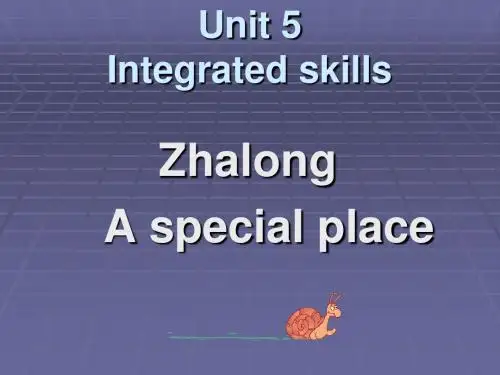
基于主题意义的初中英语阅读教学摘 要:英语阅读教学要以主题为引领,将语言知识学习、文化内涵理解、语言技能发展和学习策略运用融合到教学活动中。
本文从“确定文章的主题意义——解决What的问题”“研读语篇特点——解决How的问题”“探究语篇的深层含义——解决Why的问题”三方面阐述了如何在主题意义的引领下进行语篇教学。
关键词:语篇;主题意义;阅读教学作者简介:邹超一(1981.03-),四川人,南师附中江宁分校,高级教师,研究方向:初中英语阅读。
一、引言《普通高中英语课程标准(2017年版)》指出,学生对主题意义的探究应是学生学习语言的最重要内容,直接影响学生语篇理解的程度、思维发展的水平和语言学习的成效。
主题语境不仅规约着语言知识和文化知识的学习范围,还为语言学习提供意义语境,并有机渗透情感、态度和价值观。
对语篇主题意义的探究是英语阅读教学的灵魂,能帮助学生更全面掌握语篇的内容,深刻理解语篇的内涵、作者的情感态度,提高语言技能、思维品质和文化意识。
但是现在,基于主题意义的英语阅读教学还是比较薄弱,主要存在以下几个问题:(一)语篇学习活动设计低阶,缺乏主题意义引领部分英语阅读课就等同于翻译课,老师从头到尾把文本翻译一遍。
学生只理解了文章的字面意思,其语言技能、思维品质和文化意识都没有提高。
有的阅读课,老师把重点句型单独拿出来讲,使文本阅读脱离语篇和语境,学生无法体会语篇主题意义,其思维品质和文化意识难以提高。
(二)语篇学习活动设计散乱,缺乏主题统领由于缺乏主题的统领,语篇学习活动之间相互独立,缺乏关联性、综合性。
这样不便于学生构建新的知识结构,实现知识结构的内化、转变和应用。
通常会出现以下学习活动脱离主题的情况。
1.导入环节脱离主题语境。
有的老师在导入环节创设新情境教学生词,所创设的情境与主题语境没有关系,与教学内容割裂,没有连续性。
学生不能把导入环节学习的内容应用到阅读语篇环节。
2.理解应用和迁移环节脱离主题意义。
以学生为主体落实学习活动观的英语阅读课例分析作者:浦蕙来源:《中学教学参考·语英版》2023年第12期[摘要]英语课程具有实践性的特征,教师只有把“以教师为主体”的课堂转变为“以学生为主体”的课堂,才能实现英语教学根本目标,提升学生英语学科核心素养。
教师要把握课程目标,深入研读语篇,了解学生学情,设计适切的学习活动,让学生在体验中学习、在实践中运用、在迁移中创新,落实英语学习活动观,让“以学生为主体”的教学在英语阅读课堂中生动地发生和进行。
[关键词]以学生为主体;学习活动观;英语阅读课[中图分类号] G633.41 [文献标识码] A [文章编号] 1674-6058(2023)34-0019-04学生的学习过程是知识和技能获得与形成的过程,语言学习体现在输出与表达、交流与交际等方面,因此,实践性成为英语课程的特征之一。
传统的英语教学形式多以教师讲授语言知识和文化知识、学生记忆和操练为主,语言在真实情景中的运用往往不被重视,部分学生对文化的理解及其思维层面的发展不太理想。
而英语阅读课要以语篇为载体,培养学生的阅读技能,发展学生的阅读思维,并实现教材单元主题意义的目标,落实立德树人的根本任务。
这就需要教师以学生为主体,在英语阅读课堂上充分调动学生的积极性和主观能动性。
一、“以学生为主体”学习活动的背景《义务教育英语课程标准(2022年版)》(以下简称《课标》)中提出了学习英语课程的总目标:发展语言能力,培育文化意识,提升思维品质和提高学习能力。
基于此,传统的英语教学方式亟待改变和调整,以提升学生的英语学科核心素养。
教师要深刻认识到,学习语言的主体是学生,单纯地讲授和灌输知识难以实现知识内化,机械地操练脱离语言环境,仅记住语言而非习得语言和运用语言的学习方式,难以提升学生的思维能力和学习能力。
二、“以学生为主体”学习活动的内涵為了实现融入性的语言学习,教师应把“以教师为主体”的课堂转变为“以学生为主体”的课堂,通过一系列的课堂活动,让学生在体验中学习、在实践中运用、在迁移中创新。